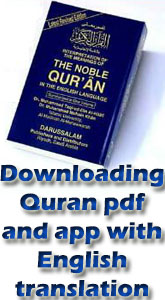Who founded Kaaba and what aspect of its changes were historical?
Question:
Who founded Kaaba and what aspect of its changes were historical?
Answer:
It was repeatedly transmitted that Abraham (a`) was the founder of Kaabah. Those residing in the vicinity of Kaaba were Ishmael, the son of Abraham, and Jorhom clan. Jorhom was a Yemenite clan that had accommodated in Mecca. Ishmael, the son of Abraham, chose his wife from among them and thus became relatives with one another. The clan then deviated from divine path within the holy land and God the almighty annihilated them all.
Kaaba was almost a four-sided building with four angles each pointing to one of four directions so to resist against violent tempests and hurricanes that are bent asunder hitting Kaaba.
The building of Kaaba retained its early features which Abraham had molded before Amalek and Bani Jorham reconstruct it as related from the Commander of the Faithful.
Qusai ibn Kilab, the Prophet`s ancestor took on the trusteeship of Kaaba in second century before migration, and demolished it to fortify its structure. He piled its roof with Indian palm dates` woods and branches and built Darannadwah beside it. The house- Darannadwah- was governing center and its consultation abode. He then allocated lands on each direction of Kaaba among Mecca tribes to build their houses.
Flood destroyed Kaaba five years before the appointment of the Prophet. The tribes helped to build it anew. The bricklayer was a Roman man whom an Egyptian carpenter was helping. Once they wanted to place Hajarulaswad disagreement as to which tribe is supposed to win the honor of placing Hajarulaswad occurred. They eventually decided to ask Mohammad who was hen thirty five and all the people of Mecca believed in his wisdom to be the arbiter. The Prophet demanded a cloak to put it on and then asked the tribes to clutch the cloak. He held the stone himself when they reached the installation site in eastern side of the Kaaba and placed it in its place. They decreased the site`s height as they ran short of budget in building Kaaba, which is still as tall as it was at the time. Some of the older site was left outside the boundary of new shrine as they decreased the building`s height.
It maintained its status until Abdullah, the son of Zubair, during the reign of Yazid, the son of Moaviyah, conquered Mecca. Hosain, the commander appointed by Yazid, fought Abdullah and catapulted Kaaba, which destroyed it and set fire on its cloth and woods on roof. In the midst of the battle, Yazid died and Hosain quit fighting. Abdullah, the son of Zubair, decided to destroy Kaaba and reconstruct it. In order to do this, he imported clean plaster from Yemen and built Kaaba by it and included Ishmael Stone inside its territory, set its door even with the ground, and devised another door across from this door so that people enter it from a door and leave it from another. He set ıts heıght as twenty seven gazes each of whıch ıs almost equal to 90 centımeters. When they were done with building Kaaba, he ordered to splash fragrances of musk and others inside the Holy Kaaba and drape it with silk. They finished Kaaba on Rajab 17th of 64 according to lunar calander.
After Abdul Malek Marvan took the throne, he ordered Hajjaj his troop`s commander to fight Abdullah, the son of Zubair, He defeated the son of Zubair and killed him. Then, he entered Holy Kaaba and let Maran know of the distortions effected by Abdullah in Kaaba. Marvan ordered to retrieve Kaaba to its early condition.
Hajjaj, Marvan`s commander, destructed six gazes and a span in its northern side, rebuilt the wall on the foundations set bu Quraysh. He then moved up the door above the ground and blocked the western door and paved its floor with marbles and limestone.
When Ottomon emperor Sultan Suleiman took the throne in 960 based on lunar calander changed theKaaba`s roof. In 1021 Sultan Ahmad repaired Kaaba. In 1039 a huge flood happened and destroyed Kaaba`s northern, eastern and western walls. Sultan Murad, the fourth, ordered to reconstruct the damages. Since then, Kaaba has not changed.
Refrence:
Source: Arfa`, Seyed Kazim, “200porsesh ve 200 pasokh”, Vol.1, Tehran, Feid Kashani publications, second edition, 1386
Translation by: AhlulBayt News Agency (a.s) (Abna.ir)
Ashura
- The Third Imam, Husayn Ibn ‘Ali (as)
- A brief look at the Life of Imam Hussein
- Karbala – the Rendezvous of Faith
- In the School of Imam Husain (AS) – 2
- In the school of Imam Husain (AS) - 1
- Ziarat-e-Ashura
- The Imam Husayn's Concepts of Religion and Leadership
- Karbala and the Imam Husayn in Persian And Indo-Muslim literature
- Hazrat Zainab's(s.a) Marriage
- Hazrat Zainab (s.a.) and Imamate
- Hazrat Zainab (s.a.) in Karbala
- Who was Yazid?
- SHIMR B. ZIL JAWSHAN
- The Imam’s Brother, ‘Abbās's Martyrdom
- The Martyrdom of Abalfazl-Abbas(A)
- The short life History of Hadhrat Abbas (as)
- Titles of Hazrat Abbas (a.s.)
- The Imam’s Brother, ‘Abbās's Martyrdom
- A short biography of Hazrat Ummul-Baneen (s.a)
- The Standard Bearer of Husain
Articles
- The Actions of God
- Methods of Tabligh (propagation)
- The Signs of the Appearance (Zuhur) of the Mahdi
- Further Investigation in the Hadith-Reports
- How Will the Imam Know That the Time for the Appearance (Zuhur) Has Come?
- The Minds of the People Prepare for the Advent of the Mahdi
- The Residence of the Twelfth Imam
- The Research about Longevity
- The Sunni Books on the Characteristics of the Mahdi
- Why Did Not the Occultation Become Complete from the Beginning?
- Can a Five Year Old Boy Become an Imam?
- Who Was the Imam after Hasan Al-'Askari?
- The Unseen World and the Imam of the Age
- Mahdiism, the Jews, and the Iranians
- The Pseudo-Mahdis
- The Beginning of the Belief in the Mahdi
- Love, Sexual Discipline and Chastity. Democratic Morality, Love in Personality Growth
- Basic Need for Humane Conditioning of Natural Instincts And Desires
- A Critical Examination of The Theoretical Basis of The Proposed New Sexual Freedom
- Proposed New Sexual Freedom
Shiite Studies
- Who is a Real Shia Muslim?
- SHI'ITE RELIGIOUS THOUGHT
- Heavenly Warrant
- What does “Shi‘ah” mean?
- Why do the Shī‘ah prostrate on turbah (dried clay)?
- Is according to Islam religion separate from politics?
- What are the sources of Shī‘ī jurisprudence (fiqh)?
- Shia’ jurisprudence
- The features of Shia' ethics
- 22 Not a new lifestyle
Wahabiyat

I am a film writer writing a film presently with the aim of promoting Islamic unity and solidarity
the most visited materials
- Who Is Almighty Allah? (250099)
- Who is a Real Shia Muslim? (235822)
- Islam and Its Social System (232678)
- Brief History of Religions (231966)
- How I find that Islam does not Oppress Women? (231751)
- Islam Attacks Slavery 1 (230911)
- The Clearest Reason for Free Will (230060)
- The Advantages of Religion 1 (229453)
- Attributes of The Real Follower of Imams in Their Teachings (226713)
- Fundamental principles of Islam (225510)
- RIGHTS OF SCHOLARS (224768)
- The Rights Islam Offers to Women (224082)
- What are the differences between Shia and Sunni Muslims؟ (223186)
- Islam Various Systems (222303)
Islam Studies
- Fundamental principles of Islam (225510)
- RIGHTS OF SCHOLARS (224768)
- Islam Various Systems (222303)
- Some Hadithes on the Faith of AbuTalib (125214)
- Islam and the Genuine Needs of Every Epoch (115723)
- Islam and Racism (112910)
- Why did God locate Kaaba in a barren desert? (106514)
- Islam and Traditional Sexual Ethics (103656)
- Does Islam permit Contraception? (103404)
- Importance of Marriage in Islam (102233)
- How to ponder on the Philosophy of Islamic Laws? (93578)
- Is there any consensus on prohibition of constructing mausoleum? (92810)
Judaism،Christianity
- I attended Muslim prayers several years ago when the speaker was talking about Jesus and Islam. (70074)
- I have been fortunate in the sense that I had a Muslim father and a Christian Mother. (69839)
- Sir I was looking for some precise proof of our belief that the Bible available in the current time is corrupt, through protestant beliefs and the proofs being scientific as well. (61316)
- What does Islam say about Prophet Isa (pbuh) walking on water? (58078)
- Is it a sin reading the Bible? (57575)
- Do Christians acknowledge the Prophethood of Khidhr and recognize him officially? (57337)
- Is it true that Lady Maryam would receive food and fruit from heaven? (56597)
- In verse 55 of Aal-i Imran, God states that: (55644)
- What do Jews say about the return of Prophet Isa (pbuh) or the coming of the Promised Messiah? (54666)
























